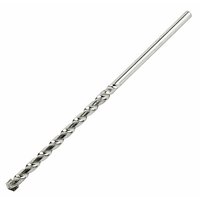

Note that it’s vital that you choose the right type of SDS masonry drill bit. It’s impossible for the drill bit to slip even under heavy load. Shanks on SDS, SDS Plus, and SDS Max shanks are slotted. This allows a standard three-jaw drill chuck to grip them more firmly.

Shank: The drill bit shank is usually round, though some have three flat sides and some are hexagonal. Manufacturers often claim their flute design is better than those of competitors, but we haven’t been able to detect any major difference. In fact, some masonry drills (typically those used for granite, slate, or natural stone) don’t have flutes at all, just a plain shaft. They are for clearing waste, drawing it backward out of the hole. The twists - properly called flutes - don’t actually do any cutting. Tip: Unlike standard drill bits, which have a point and cutting edges along the sides, all the action from a masonry drill bit comes from the broad triangular tip and shoulders, which are noticeably wider than the rest of the bit. While the bits can be considerably larger - and up to several feet long - the drill bit structure is largely the same. Heavy-duty versions fit into powerful Slotted Drive System (SDS) and rotary hammer drills. The rapid impact added to rotation makes it the most efficient way to cut through brick, block, concrete, and so on. Most masonry drill bits are designed to be used in a hammer drill. If the bit snags, the drill itself can twist violently and potentially cause a nasty sprain. Make sure you’ve got a firm grip on the tool when drilling rough concrete or stone walls.


 0 kommentar(er)
0 kommentar(er)
